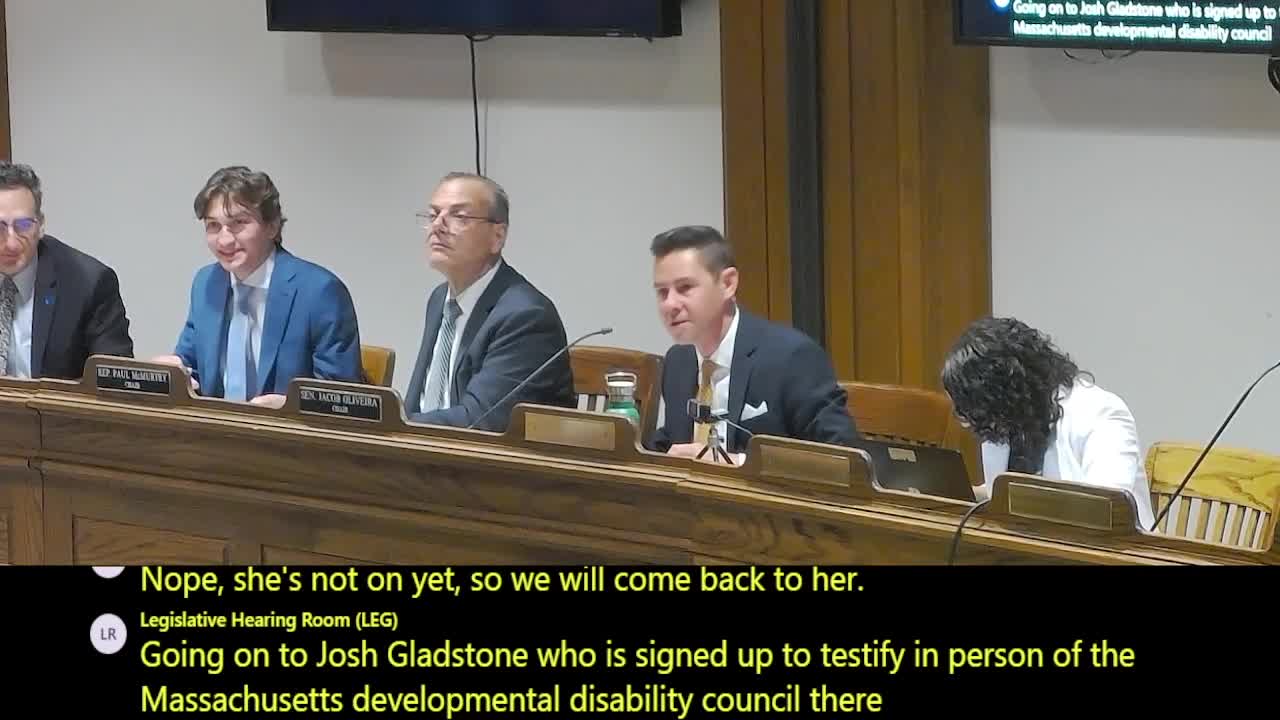Families, disability advocates press legislature to boost pay for direct‑care workforce
October 08, 2025 | 2025 Legislature MA, Massachusetts
This article was created by AI summarizing key points discussed. AI makes mistakes, so for full details and context, please refer to the video of the full meeting. Please report any errors so we can fix them. Report an error »

BOSTON — A broad coalition of disability advocates, service providers and family members urged the Joint Committee on Labor and Workforce Development on Oct. 14 to support legislation to raise wages and stabilize the direct care workforce that serves people with intellectual and developmental disabilities.
Witnesses said low pay drives high turnover in a job that requires medical, behavioral and daily‑living supports, and that shortages are delaying placements and services.
Josh Gladstone, disability policy specialist at the Massachusetts Developmental Disability Council, said direct care workers provide a wide range of supports beyond basic care, including employment help and crisis intervention. “This is a vital job,” Gladstone said, and cited federal research that shows many direct care workers live below 200% of the federal poverty level.
Mara Sullivan, CEO of The Arc of Massachusetts, described about 2,000 people with disabilities currently waiting for services in the state because of workforce vacancies and asked lawmakers to “bring chapter 257 workforce rates up to the 75th percentile of BLS” to retain staff. Paul Lutfi and other parents described tasks such as using lifts, seizure management and other medical responsibilities that require trained, consistent staff.
Speakers described consequences when staffing failed: missed renewals of MassHealth that left clients without services, transportation gaps, and family members stepping in as unpaid caregivers. Ben (last name withheld in testimony), an EMT and UMass volunteer who works with a client named Lee, recounted finding Lee with a dangerously high blood sugar after a personal care attendant stopped showing up; the episode required hospital care and a month‑long re‑enrollment in benefits.
Advocates asked the committee to report favorably on bills including H2104 and S1325 (meeting human services demand) and related funding and rate adjustments tied to Chapter 257. No formal vote was taken at the hearing.
Committee members asked about the size of wage increases and program costs; witnesses said some proposals target substantial percentile increases to Bureau of Labor Statistics benchmarks and that specific funding details would shape final legislative language.
Witnesses said low pay drives high turnover in a job that requires medical, behavioral and daily‑living supports, and that shortages are delaying placements and services.
Josh Gladstone, disability policy specialist at the Massachusetts Developmental Disability Council, said direct care workers provide a wide range of supports beyond basic care, including employment help and crisis intervention. “This is a vital job,” Gladstone said, and cited federal research that shows many direct care workers live below 200% of the federal poverty level.
Mara Sullivan, CEO of The Arc of Massachusetts, described about 2,000 people with disabilities currently waiting for services in the state because of workforce vacancies and asked lawmakers to “bring chapter 257 workforce rates up to the 75th percentile of BLS” to retain staff. Paul Lutfi and other parents described tasks such as using lifts, seizure management and other medical responsibilities that require trained, consistent staff.
Speakers described consequences when staffing failed: missed renewals of MassHealth that left clients without services, transportation gaps, and family members stepping in as unpaid caregivers. Ben (last name withheld in testimony), an EMT and UMass volunteer who works with a client named Lee, recounted finding Lee with a dangerously high blood sugar after a personal care attendant stopped showing up; the episode required hospital care and a month‑long re‑enrollment in benefits.
Advocates asked the committee to report favorably on bills including H2104 and S1325 (meeting human services demand) and related funding and rate adjustments tied to Chapter 257. No formal vote was taken at the hearing.
Committee members asked about the size of wage increases and program costs; witnesses said some proposals target substantial percentile increases to Bureau of Labor Statistics benchmarks and that specific funding details would shape final legislative language.
View full meeting
This article is based on a recent meeting—watch the full video and explore the complete transcript for deeper insights into the discussion.
View full meeting
